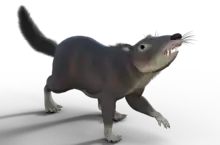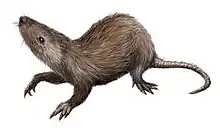Allotheria
Allotheria (meaning "other beasts", from the Greek αλλός, allos–other and θήριον, therion–wild animal) is an extinct branch of successful Mesozoic mammals. The most important characteristic was the presence of lower molariform teeth equipped with two longitudinal rows of cusps.[1] Allotheria includes Multituberculata, Gondwanatheria (which may be part of Multituberculata, as the sister group to Cimolodonta),[2][3][4][5] and probably Haramiyida,[6] although some studies show them to be more basal mammaliaforms rather than true mammals, therefore differing from true allotheres significantly.[7][8]
| Allotheria | |
|---|---|
 | |
| Skull of Ptilodus | |
| Scientific classification | |
| Kingdom: | Animalia |
| Phylum: | Chordata |
| Class: | Mammalia |
| Subclass: | Theriiformes |
| Infraclass: | †Allotheria Marsh, 1880 |
| Subgroups | |
| |
Allotheres also had a narrow pelvis, indicating that they gave birth to tiny helpless young like marsupials or laid eggs and gave milk to feed their young like monotremes do. This is a feature of all non-placental mammals.[9]
Interpretations
When he first identified Allotheria in 1880, Othniel Marsh regarded this group as an order within Marsupialia. However, in 1997 McKenna and Bell classified Allotheria as an infraclass.
References
- Butler, P.M. (2000). "Review of the early allotherian mammals". Acta Palaeontologica Polonica. 45 (4): 317–342.
- Krause, D. W.; Prasad, G. V. R.; von Koenigswald, W.; Sahni, A.; Grine, F. E. (1997). "Cosmopolitanism among Gondwanan Late Cretaceous mammals" (PDF). Nature. 390 (6659): 504–507. Bibcode:1997Natur.390..504K. doi:10.1038/37343. S2CID 205025618. Archived from the original (PDF) on 2010-06-11.
- Krause, David W.; Hoffmann, Simone; Wible, John R.; Kirk, E. Christopher; Schultz, Julia A.; von Koenigswald, Wighart; Groenke, Joseph R.; Rossie, James B. (2014-11-05). O'Connor, Patrick M., Seiffert, Erik R., Dumont, Elizabeth R., Holloway, Waymon L., Rogers, Raymond R., Rahantarisoa, Lydia J., Kemp, Addison D., Andriamialison, Haingoson. "First cranial remains of a gondwanatherian mammal reveal remarkable mosaicism". Nature. Nature Publishing Group, a division of Macmillan Publishers Limited. 515 (7528): 512–517. Bibcode:2014Natur.515..512K. doi:10.1038/nature13922. ISSN 1476-4687. PMID 25383528. S2CID 4395258.
- Drake, Nadia (November 5, 2014). "Fossil From Dinosaur Era Reveals Big Mammal With Super Senses". nationalgeographic.com. National Geographic Society. Retrieved November 5, 2014.
- Wilford, John Noble (November 5, 2014). "Fossil's Unusual Size and Location Offer Clues in Evolution of Mammals". The New York Times. Retrieved November 6, 2014.
- Luo, Z.-X.; Kielan-Jaworowska, Z.; Cifelli, R.L. (2002). "In quest for a phylogeny of Mesozoic mammals". Acta Palaeontologica Polonica. 47 (1): 1–78.
- Chang, Kenneth (16 November 2015). "Jawbone in Rock May Clear Up a Mammal Family Mystery". The New York Times. Retrieved 17 November 2015.
- Luo, Zhe-Xi; Gates, Stephen M.; Jenkins Jr., Farish A.; Amaral, William W.; Shubin, Neil H. (16 November 2015). "Mandibular and dental characteristics of Late Triassic mammaliaform Haramiyavia and their ramifications for basal mammal evolution". PNAS. 112 (51): E7101–E7109. Bibcode:2015PNAS..112E7101L. doi:10.1073/pnas.1519387112. PMC 4697399. PMID 26630008. Retrieved 17 November 2015.
- Michael L. Power,Jay Schulkin (October 2012). The Evolution Of The Human Placenta. pp. 68–. ISBN 9781421406435.
Further reading
Zofia Kielan-Jaworowska, Richard L. Cifelli, and Zhe-Xi Luo, Mammals from the Age of Dinosaurs: Origins, Evolution, and Structure (New York: Columbia University Press, 2004), 249.







